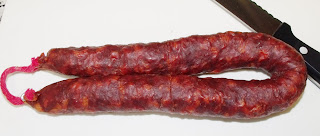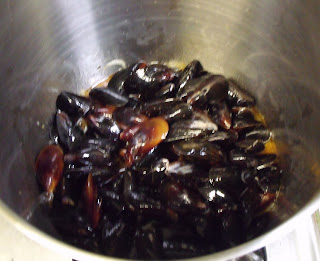Yup, I've been slacking off again, I know. Work is busy, I've been feeling run down, blah blah. This hasn't stopped me from cooking, but I have been slacking in the posting department, considering that whenever I've been in front of a computer, I've been doing work instead of writing about food. Anyway, I'm playing catch-up and will post about the dish I made last week... next week. But first, let's talk about moules à la Portugaise.
Now, there are a lot of DC Metro area food blogs that boast about the excellent fresh ingredients that can be found in this fair city. This is great, for some, but not so much for me. Why is that? Simple--I don't own a car. So the good ethnic shops in particular (and any non-metro accessible shops generally) are out of reach without some serious advanced planning.
This weekend we decided to do some of said advanced planning in order to make some purchases that needed to be transported by car. Husband J arranged to rent a zipcar for the morning, and asked me whether I'd like to visit BlackSalt, a fish market and restaurant in the Palisades (near Georgetown, another desolate and metro-less region, in my opinion). BlackSalt is known as THE place to get good, fresh seafood in the District, so of course I jumped at the chance to actually visit. In preparation, I decided to give them a call to see if they had any of the seafood I needed for some of my
Les Halles Cookbook recipes. But when I called, asking what they might have in stock over the next couple of days, I got a terse "call tomorrow; I buy my fish daily" from the head fishmonger, in a tone that told me this conversation was OVER.
Uh RUDE MUCH? No asking what I had in mind, or discussion of what might be available at this time generally? So much for asking whether pike or monkfish might be available (or if they have a season at all). I was a bit miffed, but those of you who know me know that I'm not quick to write off stores or people after one bad experience, everyone has off days. So I decided to go the next day to see what was available and get a feel for the place.
So, like I said, BlackSalt is a restaurant and fish market. The two shops are not separated, but combined, with the market in the front of the shop, and tables ranging from the front to the back, which looks like a more traditional restaurant. We went early on Saturday morning, so the restaurant was empty, but there were already a lot of customers looking over the fish counter. The counter held a lot of beautiful, gleaming seafood, including cuts, heads, whole fish, and other tasty creatures. Unfortunately, no monkfish tails, pike, crawfish, or any of the other fish called for in my recipes. I was considering whether to go for some tender-looking monkfish cheeks when I spotted some Prince Edward Island mussels for $3.99 a pound. Another mussel dish would be perfect for the warm, rainy weather, so I decided to go for those. I bought three pounds, and a small jar of salmon roe as a treat.
On the way back, I asked Husband J which mussel dish he would like among the four left in the book, and he decided on moules à la Portugaise, which features DELICIOUS CHORIZO in the sauce. I told him that his duty, then, would be to find some chorizo. He accomplished this easily by checking out a new charcouterie market that recently opened in our neighborhood, and happens to stock house-made chorizo. Brilliant! The chorizo he found was dry, but still the red, fresh chorizo that Tony prefers in his recipe, rather than the drier, white-mold covered dark chorizo favored by more traditional Portuguese cooks. I'd like to try the darker chorizo, but I'm not going to turn my nose up at local house-made chorizo, for sure.
 Red, greasy and delicious.
Red, greasy and delicious.Though the recipe calls for 6 lbs of mussels, and I bought 3 lbs (to feed 2 instead of 4), I decided to make the full recipe for the sauce, since that is after all the most delicious part.
First, I heated some olive oil in a large pot, and sauteed half an onion, six cloves of garlic, and two ounces of the chorizo. (The recipe calls for 1 oz, but I decided to double it, since Husband J bought an 8 oz link. That's a lot of leftover chorizo, and I am looking forward to some chorizo scrambled eggs in my immediate future.)

While those were cooking, I scrubbed and inspected the mussels, one at a time. Unlike the Whole Foods mussels, most of the BlackSalt mussels were tightly closed, or closed when I tapped the shell, signifying that they were alive. I tossed less than 1/5 of the mussels, making these a much better value.
Once the chorizo released its red, spicy scented grease, I added some white wine, salt, and pepper. Then I dumped in the mussels to steam under lid until they opened up.
 A quick, blurry photo of mussels starting to steam.
A quick, blurry photo of mussels starting to steam.After the mussels opened, I threw in a handful of chopped parsley and cilantro, shook the whole pot, and served it up with slices of french bread (again house-made from the charcuterie shop).

Well, one thing is for sure, I will never buy mussels from Whole Foods again. These mussels put the old ones to shame. These were very tender and meaty with a great subtle seafood flavor. The sauce was brilliant, filled with chorizo grease, and was very delicious when mopped up with the bread. Of course the slices of chorizo were probably the best part.
All in all, this was a great and easy meal for a rainy weekend afternoon.
Lessons Learned: Most importantly, that a good cook needs to know how to find great ingredients, whether it's from a shop that's usually out of reach or a new neighborhood joint with some delicious surprises. But next time I'll probably be more aggressive about finding out whether the fish I need is in the shop before going to the trouble of renting a car and traveling out to the shops.
Next Week: I'll write about the lamb stew I made last week.








